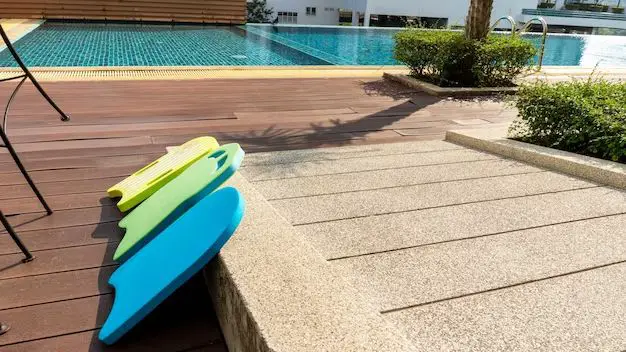Page Contents
Quick Answer
The cheapest thing to put around a pool is plastic fencing. Plastic fencing, sometimes called PVC fencing, is inexpensive, easy to install, and provides an effective barrier around the pool area. Other cheap fencing options include chain link and wood privacy fences. Ultimately, plastic fencing offers the best combination of affordability, durability, and safety for securing a pool.
What Are the Cheapest Fencing Options for Around a Pool?
When choosing a pool fence, cost is often the primary concern. Here are some of the cheapest fencing options to consider:
Plastic Fencing
Plastic fencing, also known as vinyl or PVC fencing, is generally the most affordable option for pool fences. Plastic fencing costs approximately $20-$30 per linear foot installed. The main advantages of plastic fencing include:
- Low cost – Generally less than $1 per linear foot for materials.
- Durability – Vinyl resists weathering, rotting, and rust.
- Low maintenance – Requires occasional cleaning but no paint or stain.
- Customizable – Comes in a variety of colors and designs.
- Safe – Meets pool code requirements.
- Easy installation – Components fit together simply.
Chain Link Fencing
Chain link fencing is another economical choice for enclosing a pool. Chain link fencing costs around $15-$25 per linear foot installed. The pros of chain link fencing are:
- Inexpensive – Materials often less than $1 per linear foot.
- Simple installation – Can be DIY project.
- Good visibility – Can see through to pool.
- Withstands weather – Won’t rot or rust.
However, chain link has a more industrial look that may not be aesthetically pleasing for all spaces.
Wood Privacy Fencing
Basic wood privacy fencing typically runs $15-$30 per linear foot installed. The benefits of wood fencing include:
- Affordable materials – Especially pine or cedar boards.
- Attractive natural appearance.
- Good privacy.
- Can stain or paint for customized look.
But wood fences require more maintenance over time and may not last as long as vinyl or chain link.
What Should You Look for When Choosing Pool Fencing?
When selecting an affordable pool fence, be sure to consider:
Safety
The fence must fully enclose the pool and measure at least 4-5 feet high to prevent children and pets from entering unattended. Check local building codes for height and gate latch requirements. Avoid large gaps or climbing points.
Durability
Look for long-lasting materials that can stand up to sun, rain, and humidity around a pool environment. Avoid fences prone to deterioration, sagging, or discoloration over time.
Appearance
Choose a fence style and color that fits your yard and complements your poolscape. Clean lines and unobtrusive colors help the fence blend in.
Maintenance
Low maintenance fences, like vinyl, aluminum, or coated chain link, allow you to spend less time and money on upkeep. Wood and wrought iron fences require more regular sealing, painting, or staining.
Cost
Compare total project costs, not just materials. Look at the cost to purchase, ship, install, and maintain different fences over time.
How Much Does Pool Fencing Cost?
Pool fencing costs vary based on the type of material, height, and installation. Here are some average installed costs for common pool fence options:
| Pool Fence Material | Cost per Linear Foot Installed |
|---|---|
| Chain Link | $15 – $25 |
| Plastic | $20 – $40 |
| Aluminum | $35 – $50 |
| Wood | $15 – $35 |
| Wrought Iron | $45 – $100 |
These are approximate costs based on standard 4-6 foot tall fencing. Factors like custom designs, premium materials, and complex installations can increase prices significantly. Get contractor quotes to find exact pricing for your specific project.
How Do I Make My Pool Fence More Affordable?
If you’re looking to save money on your pool fence, consider these tips:
Choose Cost-Effective Materials
Chain link, plastic, and basic wood are the cheapest fencing materials. Avoid premium woods, ornamental metals, and complicated patterns. Save custom designs for small accent sections only.
Reduce Fence Height
If local codes allow, having a shorter 3-4 foot fence can significantly reduce costs. This may work for above ground pools. However, always ensure the fence meets safety standards.
DIY Installation
Doing it yourself can save on labor. Chain link, wood, and plastic fences often do not require specialized skills to install. Check that DIY assembly meets code.
Buy Materials in Bulk
Purchasing fencing by the truckload direct from manufacturers or wholesalers can lead to volume discounts. Coordinate with contractors.
Use Coupons and Sales
Big box stores often run promotions on fencing materials during spring and summer peak pool season. Timing purchases right can save 10-20%.
Get Multiple Quotes
To find the best deal, get bids from at least 3 reputable contractors. Compare materials and labor costs.
Conclusion
The most economical option for enclosing a pool is plastic fencing, which provides cost-effective reliability, safety, and low maintenance. While chain link and basic wood fencing can also be budget-friendly, plastic vinyl fencing gives the best value by combining affordability with curb appeal, durability, and customization options. Following pool safety building codes and contractor installation recommendations is a must, even with affordable fencing, to ensure effective protection. Investing in quality pool fencing saves money in the long run and prevents tragic accidents.
